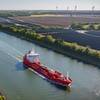By David Tinsley, technical editor
Power systems specialist Rolls-Royce now derives nearly $1.5 billion of total annual sales of $8.7 billion from the marine market, and an important element of its growth strategy in the marine domain is the development of its electrical capabilities, products and technology. The increasing use of electrical drives and other sub-systems, and a move towards highly automated, integrated shipboard networks, is evident in both the commercial and naval sectors, in the technology-intensive, specialized vessel categories which form the group's heartland business areas. The success of electrical power and propulsion systems in application to high capacity cruise vessels has proved to be one of the most significant technological developments in commercial shipping over the past decade and a half, and electric drives are finding an ever-broadening market in the offshore and tanker sectors and other fields. In the naval business, most new vessels larger than frigates are being designed with electrical propulsion systems.
As in cruise vessels, integrated shipboard systems are increasingly favored, whereby the network supplies electrical energy for the hotel load and all other consumers as well as for propulsion. Navies are moving towards the integrated full electric propulsion concept, requiring new power electronic technologies to link power generation, propulsion and distribution systems.
Recognizing the need to respond to market dynamics, by providing more sophisticated electrical solutions, Rolls-Royce created a dedicated, Marine Electrical Systems business unit last year, under the direction of Rick Kane. The business embraces the group's electrical propulsion and power, marine automation and control, and motion control systems, and links other Rolls-Royce products such as prime movers, propellers and thrusters. It is tasked with developing and delivering fully integrated solutions for applications up to 100-MW.
Laying down building blocks for the future, Rolls-Royce plans to expand internal design engineering and integration resources and create new technology demonstrators and test facilities, while also entering into partnering arrangements with electrical motor, drive and generator manufacturers. Determination to build capability and extend market reach found early expression in August's takeover of UK-based VT Controls, with its strong naval market presence in power and automation systems. The company's Cosham site at Portsmouth is now the headquarters for the Marine Electrical Systems business.
Kane explained that Rolls-Royce is targeting expansion for Marine Electrical Systems through organic growth and strategic acquisitions. It is creating a team capable of designing and developing electrical machines and components, and regards partnering with selected manufacturers, in the field of power conversion and rotating electrical machinery, as an important plank of strategy. New technologies are being developed to provide competitive electrical products and systems, such as for dedicated packaging of marine drives and specialized motor designs. One current project involves the development of a transverse flux motor, aimed at achieving a high torque density factor for new designs of alternator or podded electric drives, for example.
Marine Electrical Systems is now in the process of establishing a new test facility at Blyth, in north-east England. The waterfront site, which includes a former commercial drydock, will allow the company to test marine electrical and mechanical load systems, closely replicating the topology and inter-connectivity of shipboard networks. The business will also use the new complex to create innovative control and protection methods for integrated marine electric systems, and to prepare technology demonstrators. The investment at Blyth underscores a growing demand from the market, not least in the naval sector, for significant 'de-risking' of new products and systems. The electrical systems business draws together the group's marine automation and control activities based at Longva, near Aalesund, in western Norway, the motion control know-how deriving from the Brown Brothers fin stabilization and Intering tank stabilization units in the UK and Germany, respectively, and the power electrical systems engineering based in the UK.
Among the key goals is the leverage of existing electrical systems, automation, integrated controls, motion control and modelling and simulation capabilities to expand market share, and the continued development of a common control architecture as a platform for all products. Elements of the common platform are already being used in control systems for Bergen diesel engines and the new MT30 marine gas turbine, in new joystick controls, UMAS automation systems, and elsewhere. Rolls-Royce is adding a new string to its bow through the development of its own dynamic positioning (DP) technology. The projected range will extend from a station-keeping system, known as the Compact DP, through to DP-3 triple redundant systems for demanding offshore industry requirements. The DP systems will build upon the common controls platform achitecture. The group's DP core technology will comprise an operator workstation, operator panel and graphical display linked to the main control cabinet and controller by the control network, interfaced to integrated bridge systems, sensors and position reference systems. The unit will send instructions to, and receive feedback from, the power plant, propulsors and maneuvering equipment. A further set of interfaces can exchange data with support, monitoring and advisory systems, which may include consequence monitoring, data logging and report tools, vessel simulators and health monitoring arrangements. Rolls-Royce automation and control equipment featuring the next generation UMAS system is to be employed in the initiative with Furuno relating to integrated bridge systems (IBS). Sealed last June, the pact between the two groups is centered on the use of Furuno Integrated Navigation System(INS) products in Rolls-Royce ship systems, as well as on the use of Rolls-Royce automation and control products in Furuno sales to the commercial marine market. As a prime example of Rolls-Royce's predilection for selective industrial collaboration, the U.K.-owned group and Furuno are jointly developing elements of the IBS to optimize flexible use of equipment and displays, improve information flow and system functionality, and enhance man-machine interface (MMI) design. A pilot installation is expected to be ready for installation by mid 2004, and a UT-series offshore support vessel is a candidate for the initial application.
Rolls-Royce is also planning to consolidate and develop its modelling and simulation capabilities, to provide a systems engineering, integration and analysis tool to evaluate design alternatives and optimise performance under various conditions. It is felt that this will additionally be beneficial to through-life service needs, as regards both ships and systems.
It is envisioned that the Marine Electrical Systems business will bring commercial marine expertise to its already well established naval market position. Recent experience in providing full electrical propulsion, automation and other systems to sophisticated offshore vessels, such as the wind turbine installation ship Mayflower Resolution and the UT-Design support vessel Bourbon Tampen, as well as that accrued in current naval projects, strengthens its hand in developing future naval market opportunities. The group is looking to play an active role in naval vessel programs including the Royal Navy's future aircraft carriers, a new generation of frigates for the Italian and French navies, and the US DD(X) destroyers.
The site at Cosham has a power systems role in the RN's Type 45 destroyer program, supplying packages including 440V ship services switchboards, electrical distribution centres and panels, electric motor starters, transformers, and shore connection boxes. Rolls-Royce is providing the WR-21 gas turbines, propeller shaftlines, steering gear and stabilisers for the ships. MES is also designing and manufacturing switchboards and 440V load centres for the Astute-class nuclear submarine, and automation equipment for two Portuguese offshore patrol vessels.
Subscribe for
Maritime Reporter E-News
Maritime Reporter E-News is the maritime industry's largest circulation and most authoritative ENews Service, delivered to your Email five times per week










